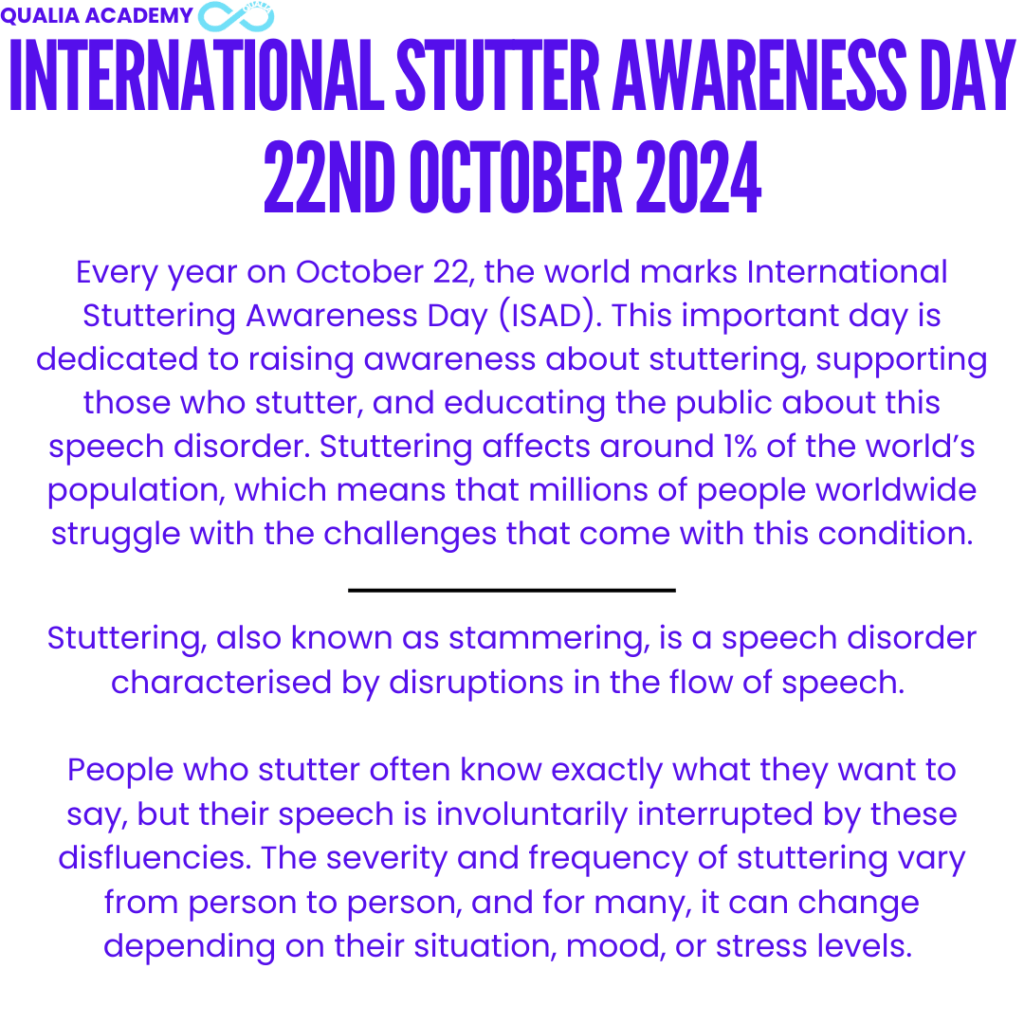Understanding Stuttering and Building Inclusive Environments

What is Stuttering Awareness Day?
Stuttering Awareness Day is every year on October 22, . This important day is dedicated to raising awareness about stuttering, supporting those who stutter, and educating the public about this speech disorder. Stuttering affects around 1% of the world’s population, which means that millions of people worldwide struggle with the challenges that come with this condition. But what exactly is stuttering, how does it occur, and how can we create more inclusive environments, particularly in workplaces, for individuals who stutter?
What is Stuttering?
Stuttering, also known as stammering, is a speech disorder characterised by disruptions in the flow of speech. These disruptions, or disfluencies, can include:
Repetitions of sounds, syllables, or words (e.g., “w-w-w-want”)
Prolongations of sounds (e.g., “ssssssand”)
Blocks or pauses where the individual struggles to produce sound
People who stutter often know exactly what they want to say, but their speech is involuntarily interrupted by these disfluencies. The severity and frequency of stuttering vary from person to person, and for many, it can change depending on their situation, mood, or stress levels.
Stuttering is not simply a nervous habit or a reflection of intelligence. It is a legitimate communication disorder that affects how speech is produced, which can have far-reaching effects on those who live with it.
How Stuttering Happen: The Causes of Stuttering
While there is no single known cause for stuttering, research has identified several contributing factors that may play a role in its development. These include:
Genetics:
Stuttering tends to run in families. Studies have shown that individuals with a family history of stuttering are more likely to develop the disorder themselves. This suggests that certain genes may predispose individuals to stutter.
Neurological Differences:
Brain imaging studies have found that people who stutter may have subtle differences in how their brains process speech and language. The coordination between the brain’s speech centres and the muscles involved in talking appears to be less synchronised, which could lead to the disfluencies associated with stuttering.
Developmental Factors:
Stuttering often begins in childhood when language skills are developing rapidly. While many children go through a period of normal disfluency as they learn to speak, persistent stuttering in some children can be linked to how the brain develops and manages speech during this critical time.
Environmental and Psychological Factors:
While these factors don’t directly cause stuttering, certain environmental triggers, such as stressful situations, high levels of anxiety, or a critical listener, can exacerbate disfluencies in people who are already predisposed to stutter.
The Impact of Stuttering on Individuals
Stuttering can significantly affect an individual’s emotional, social, and professional life. While it is primarily a speech disorder, its consequences reach beyond verbal communication.
Emotional Impact:
Many people who stutter experience feelings of frustration, embarrassment, or anxiety when they struggle to speak. These emotions can lead to low self-esteem, particularly if individuals have faced negative reactions, teasing, or bullying due to their stutter. The fear of stuttering in social or professional situations can create a cycle of anxiety that worsens the condition.
Social Impact:
Stuttering can hinder social interactions. Some individuals may avoid speaking in group settings or refrain from situations where they have to introduce themselves, ask questions, or express opinions. This avoidance behaviour can lead to social isolation. People who stutter might feel misunderstood or believe they are judged based on their speech, making it difficult for them to form and maintain relationships.
Professional Impact:
In the workplace, stuttering can present unique challenges. Many jobs require good communication skills, and individuals who stutter might fear that their disfluency will be seen as a barrier to their professional success. They may feel anxious about job interviews, speaking in meetings, or giving presentations. This fear can sometimes lead people who stutter to choose careers that require less verbal communication, even if it limits their potential.
However, it’s important to note that with the right support, people who stutter can excel in all areas of life, including their careers. In fact, many famous figures, such as Winston Churchill, Emily Blunt, and Joe Biden, have successfully managed their stutters and achieved remarkable success.
Creating Inclusive Work Environments for People Who Stutter
A critical aspect of International Stuttering Awareness Day is promoting the creation of more inclusive environments for individuals who stutter. In the workplace, this means ensuring that employees who stutter are supported, understood, and given the opportunity to thrive, free from stigma or discrimination. Here are some strategies workplaces can adopt to foster an inclusive environment:
Raise Awareness and Educate Employees About Sutters:
A key step in fostering inclusivity is increasing awareness of what stuttering is. Offer training sessions or workshops to help employees understand stuttering, debunk common myths, and learn how to interact with colleagues who stutter respectfully. It’s important to remember that stuttering is not something that should be “fixed” by others. Respect, patience, and understanding go a long way in supporting someone with a stutter.
Encourage Open Communication:
For many people who stutter, it’s helpful to openly discuss their condition with their employers and colleagues. This allows everyone to better understand their needs and preferences. Managers should encourage an environment where employees feel comfortable disclosing a stutter without fear of judgment or disadvantage. Offering employees the opportunity to discuss their speech preferences—such as avoiding interrupting or finishing their sentences—can make communication smoother.
Provide Flexibility During Interviews and Meetings:
Interviews and meetings can be particularly stressful for individuals who stutter. To create a more supportive environment, workplaces can provide alternative ways for employees to express their ideas, such as offering written responses or providing more time for verbal communication. Creating a non-pressurised, patient atmosphere during these interactions can alleviate anxiety and help people who stutter communicate more effectively.
Offer Employee Assistance Programs (EAPs):
Many companies provide Employee Assistance Programs (EAPs) that offer support services, such as speech therapy or counselling. Employers should ensure that their EAPs include resources for employees who stutter. Speech therapy can help individuals develop techniques to manage their stutter, while counselling can provide emotional support to cope with the psychological impacts of stuttering.
Foster a Culture of Patience and Respect For Stutters:
A culture that values patience and respect in communication is crucial. Encourage employees to listen attentively and avoid interrupting someone who is speaking. It’s essential to recognise that everyone communicates differently, and stuttering is just one of many forms of communication diversity that can enrich a workplace. Respectful communication ensures that people who stutter feel valued and heard.
Here at Qualia Academy, we provide resources for neurodivergent individuals, we have some resources for individuals with stutters which you can access on our Neurodiversity Website.
Contact us if you are interested in our resources.









